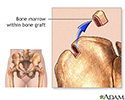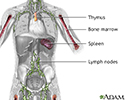Acute lymphoblastic leukemia (ALL)
ALL; Acute lymphoblastic leukemia; Acute lymphoid leukemia; Acute childhood leukemia; Cancer - acute childhood leukemia (ALL); Leukemia - acute childhood (ALL); Acute lymphocytic leukemia
Acute lymphoblastic leukemia (ALL) is a fast-growing cancer of a type of white blood cell called a lymphoblast.
ALL occurs when the bone marrow produces a large number of immature lymphoblasts. Bone marrow is the soft tissue in the center of bones that helps form all blood cells. The abnormal lymphoblasts grow quickly and replace normal cells in the bone marrow. ALL prevents healthy blood cells from being made. Life-threatening symptoms can occur as normal blood counts drop.
Causes
Most of the time, no clear cause can be found for ALL.
The following factors may play a role in the development of all types of leukemia:
- Certain chromosome problems
- Exposure to radiation, including x-rays before birth
-
Past treatment with
chemotherapy
drugs
Chemotherapy
The term chemotherapy is used to describe cancer-killing drugs. Chemotherapy may be used to:Cure the cancerShrink the cancerPrevent the cancer from ...
 ImageRead Article Now Book Mark Article
ImageRead Article Now Book Mark Article - Receiving a bone marrow transplant
-
Toxins
, such as benzene
Toxins
Toxins are substances created by plants and animals that are poisonous to humans. Toxins also include some medicines that are helpful in small doses...
 ImageRead Article Now Book Mark Article
ImageRead Article Now Book Mark Article
The following factors are known to increase the risk of ALL:
-
Down syndrome
or other genetic disorders
Down syndrome
Down syndrome is a genetic condition in which a person has 47 chromosomes instead of the usual 46.
Read Article Now Book Mark Article - A brother or sister with leukemia
This type of leukemia usually affects children ages 3 to 7. ALL is the most common childhood cancer, but it can also occur in adults.
Symptoms
ALL makes a person more likely to bleed and develop infections. Symptoms include:
- Bone and joint pain
- Easy bruising and bleeding (such as bleeding gums, skin bleeding, nosebleeds, abnormal periods)
- Feeling weak or tired
-
Fever
Fever
Fever is the temporary increase in the body's temperature in response to a disease or illness. A child has a fever when the temperature is at or abov...
 ImageRead Article Now Book Mark Article
ImageRead Article Now Book Mark Article - Loss of appetite and weight loss
-
Paleness
Paleness
Paleness is an abnormal loss of color from normal skin or mucous membranes.
 ImageRead Article Now Book Mark Article
ImageRead Article Now Book Mark Article - Pain or feeling of fullness below the ribs
-
Pinpoint red spots
on the skin (petechiae)
Pinpoint red spots
Bleeding into the skin can occur from broken blood vessels that form tiny red dots (called petechiae). Blood also can collect under the tissue in la...
 ImageRead Article Now Book Mark Article
ImageRead Article Now Book Mark Article -
Swollen lymph nodes
in the neck, under arms, and groin
Swollen lymph nodes
Lymph nodes are present throughout your body. They are an important part of your immune system. Lymph nodes help your body recognize and fight germ...
 ImageRead Article Now Book Mark Article
ImageRead Article Now Book Mark Article - Night sweats
These symptoms can occur with other conditions. Talk to a health care provider about the meaning of specific symptoms.
Exams and Tests
A physical exam may reveal the following:
- Bruising
-
Enlarged liver
, lymph nodes, and spleen
Enlarged liver
Hepatomegaly is swelling of the liver beyond its normal size. If both the liver and spleen are enlarged, it is called hepatosplenomegaly.
 ImageRead Article Now Book Mark Article
ImageRead Article Now Book Mark Article -
Signs of bleeding (petechiae,
purpura
)
Purpura
Purpura is purple-colored spots and patches that occur on the skin, and in mucus membranes, including the lining of the mouth.
 ImageRead Article Now Book Mark Article
ImageRead Article Now Book Mark Article
Blood tests may include:
-
Complete blood count (CBC), including
white blood cell (WBC) count
White blood cell (WBC) count
A WBC count is a blood test to measure the number of white blood cells (WBCs) in the blood. WBCs help fight infections. They are also called leukocy...
 ImageRead Article Now Book Mark Article
ImageRead Article Now Book Mark Article - Platelet count
- Bone marrow biopsy
- Lumbar puncture (spinal tap) to check for leukemia cells in the spinal fluid
Tests are also done to look for changes in the DNA inside the abnormal white cells. Certain DNA changes may determine how well a person does (prognosis), and what kind of treatment is recommended.
Treatment
The first goal of treatment is to get blood counts back to normal. If this occurs and the bone marrow looks healthy under the microscope, the cancer is said to be in remission.
Chemotherapy is the first treatment tried with the goal of achieving a remission.
Chemotherapy
The term chemotherapy is used to describe cancer-killing drugs. Chemotherapy may be used to:Cure the cancerShrink the cancerPrevent the cancer from ...

- The person may need to stay in the hospital for chemotherapy. Or it can be given at a clinic and the person goes home afterward.
- Chemotherapy is given into the veins (by IV) and sometimes into the fluid around the brain (the spinal fluid).
After a remission is achieved, more treatment is given to achieve a cure. This treatment can include more IV chemotherapy or radiation to the brain . Stem cell or, bone marrow, transplant from another person may also be done. Further treatment depends on:
Radiation to the brain
Radiation - brain - discharge; Cancer-brain radiation; Lymphoma - brain radiation; Leukemia - brain radiation
Stem cell
A bone marrow transplant is a procedure to replace damaged or destroyed bone marrow with healthy bone marrow stem cells. Bone marrow is the soft, fat...

- Age and health of the person
- Genetic changes in the leukemia cells
- How many courses of chemotherapy it took to achieve remission
- If abnormal cells are still detected under the microscope
- Availability of donors for stem cell transplant
You and your provider may need to manage other concerns during your leukemia treatment, including:
-
Having chemotherapy at home
Having chemotherapy at home
Home intravenous antibiotic therapy; Central venous catheter - home; Peripheral venous catheter - home; Port - home; PICC line - home; Infusion thera...
Read Article Now Book Mark Article -
Managing your pets
during chemotherapy
Managing your pets
People with weakened immune systems may be advised to give up their pets to avoid getting diseases from the animals. People in this category include...
Read Article Now Book Mark Article -
Bleeding problems
Bleeding problems
Cancer treatment - bleeding; Chemotherapy - bleeding; Radiation - bleeding; Bone marrow transplant - bleeding; Thrombocytopenia - cancer treatment...
Read Article Now Book Mark Article -
Dry mouth
Dry mouth
Chemotherapy - dry mouth; Radiation therapy - dry mouth; Transplant - dry mouth; Transplantation - dry mouth
Read Article Now Book Mark Article -
Eating enough calories
Eating enough calories
Getting more calories - adults; Chemotherapy - calories; Transplant - calories; Cancer treatment - calories
Read Article Now Book Mark Article -
Safe eating
during cancer treatment
Safe eating
Cancer treatment - eating safely; Chemotherapy - eating safely; Immunosuppression - eating safely; Low white blood cell count - eating safely; Neutro...
Read Article Now Book Mark Article
Support Groups
You can ease the stress of illness by joining a cancer support group . Sharing with others who have common experiences and problems can help you not feel alone.
Cancer support group
The following organizations are good resources for information on cancer:American Cancer Society -- www. cancer. orgCancerCare -- www. cancercare. or...
Outlook (Prognosis)
Those who respond to treatment right away tend to do better. Most children with ALL can be cured. Children often have a better outcome than adults.
Possible Complications
Both leukemia itself and the treatment can lead to many problems such as bleeding, weight loss, and infections.
When to Contact a Medical Professional
Call your health care provider if you or your child develops symptoms of ALL.
Prevention
The risk of developing ALL may be reduced by avoiding contact with certain toxins, radiation, and chemicals.
References
Jeha S, Pui CH. Clinical manifestations and treatment of acute lymphoblastic leukemia in children. In: Hoffman R, Benz EJ, Silberstein LE, Heslop HE, Weitz JI, Anastasi J, eds. Hematology: Basic Principles and Practice . 6th ed. Philadelphia, PA: Elsevier Saunders; 2013:chap 64.
National Cancer Institute: PDQ adult acute lymphoblastic leukemia treatment. Bethesda, MD: National Cancer Institute. Updated January 26, 2016. www.cancer.gov/cancertopics/pdq/treatment/adultALL/HealthProfessional . Accessed March 17, 2016.
National Cancer Institute: PDQ childhood acute lymphoblastic leukemia treatment. Bethesda, MD: National Cancer Institute. Updated December 10, 2015. www.cancer.gov/cancertopics/pdq/treatment/childALL/HealthProfessional . Accessed March 17, 2016.
National Comprehensive Cancer Network. NCCN clinical practice guidelines in oncology: acute lymphoblastic leukemia. Version 2.2015. www.nccn.org/professionals/physician_gls/pdf/all.pdf . Accessed March 17, 2016.
-
Bone marrow aspiration - illustration
A small amount of bone marrow is removed during a bone marrow aspiration. The procedure is uncomfortable, but can be tolerated by both children and adults. The marrow can be studied to determine the cause of anemia, the presence of leukemia or other malignancy, or the presence of some storage diseases, in which abnormal metabolic products are stored in certain bone marrow cells.
Bone marrow aspiration
illustration
-
Acute lymphocytic leukemia - photomicrograph - illustration
This picture shows the darkly-stained lymph cells (lymphoblasts) seen in acute lymphocytic leukemia (ALL), the most common type of childhood leukemia.
Acute lymphocytic leukemia - photomicrograph
illustration
-
Auer rods - illustration
Note multiple Auer rods which are found only in acute myeloid leukemias, either myeloblastic or monoblastic. These rods consist of clumps of azurophilic granule material.
Auer rods
illustration
-
Bone marrow from hip - illustration
Bone marrow may be harvested from the hip (iliac bone) to serve as bone grafts elsewhere in the body.
Bone marrow from hip
illustration
-
Immune system structures - illustration
The immune system protects the body from potentially harmful substances. The inflammatory response (inflammation) is part of innate immunity. It occurs when tissues are injured by bacteria, trauma, toxins, heat or any other cause.
Immune system structures
illustration
-
Bone marrow aspiration - illustration
A small amount of bone marrow is removed during a bone marrow aspiration. The procedure is uncomfortable, but can be tolerated by both children and adults. The marrow can be studied to determine the cause of anemia, the presence of leukemia or other malignancy, or the presence of some storage diseases, in which abnormal metabolic products are stored in certain bone marrow cells.
Bone marrow aspiration
illustration
-
Acute lymphocytic leukemia - photomicrograph - illustration
This picture shows the darkly-stained lymph cells (lymphoblasts) seen in acute lymphocytic leukemia (ALL), the most common type of childhood leukemia.
Acute lymphocytic leukemia - photomicrograph
illustration
-
Auer rods - illustration
Note multiple Auer rods which are found only in acute myeloid leukemias, either myeloblastic or monoblastic. These rods consist of clumps of azurophilic granule material.
Auer rods
illustration
-
Bone marrow from hip - illustration
Bone marrow may be harvested from the hip (iliac bone) to serve as bone grafts elsewhere in the body.
Bone marrow from hip
illustration
-
Immune system structures - illustration
The immune system protects the body from potentially harmful substances. The inflammatory response (inflammation) is part of innate immunity. It occurs when tissues are injured by bacteria, trauma, toxins, heat or any other cause.
Immune system structures
illustration
-
Acute lymphocytic leukemia
(In-Depth)
-
Leukemia
(Alt. Medicine)
Review Date: 2/1/2016
Reviewed By: Todd Gersten, MD, Hematology/Oncology, Florida Cancer Specialists & Research Institute, Wellington, FL. Review provided by VeriMed Healthcare Network. Also reviewed by David Zieve, MD, MHA, Isla Ogilvie, PhD, and the A.D.A.M. Editorial team.





